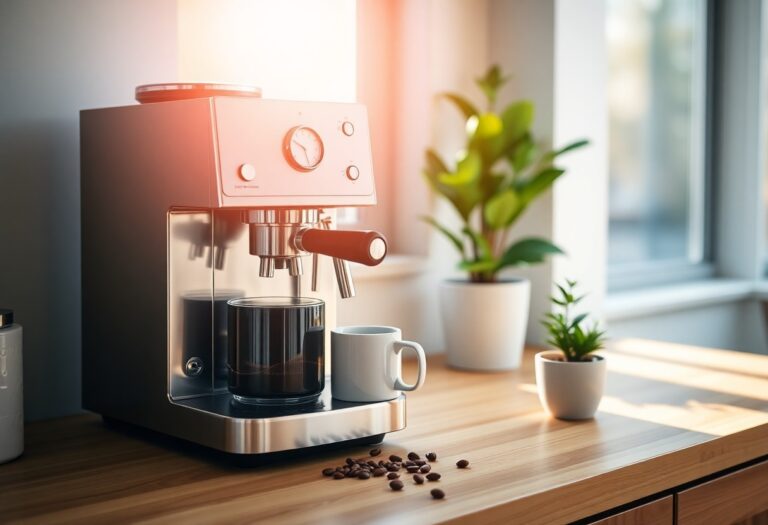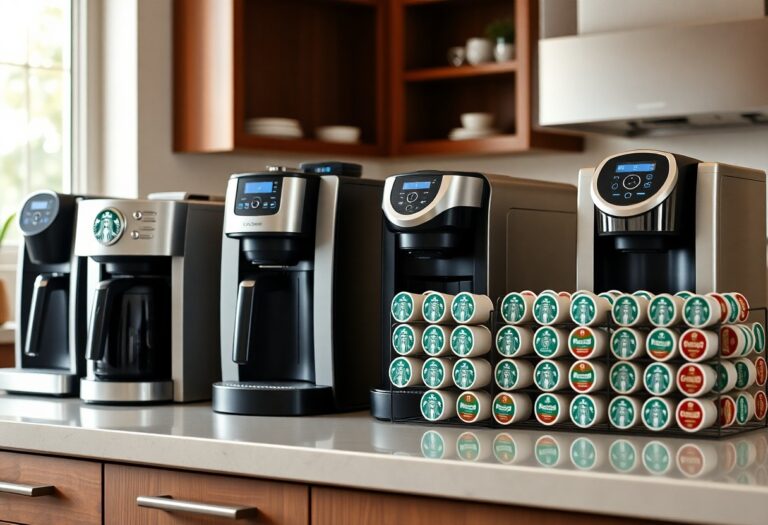How to Make Latte Coffee at Home Without a Machine
A latte is a popular coffee drink made with espresso and steamed milk, often topped with a layer of frothy milk foam.
Making a latte at home without a machine offers convenience, cost savings, and the ability to customize your drink to suit your preferences.
In this article, you will discover various methods to brew coffee base without a machine, techniques for frothing milk without an espresso machine, and tips for assembling and customizing your homemade latte.
Brewing Coffee Base Without a Machine
A strong brewed coffee or espresso substitute forms the foundation of any good homemade latte. Several methods exist to create this coffee base without relying on an espresso machine. Among them, the stovetop espresso method stands out as a popular, accessible choice that delivers rich, concentrated coffee ideal for lattes.
1. Stovetop Espresso Method
The stovetop espresso method uses a moka pot—an affordable and compact device that brews coffee by passing boiling water pressurized by steam through ground coffee. It produces a robust coffee concentrate similar to espresso, perfect for your latte.
Step-by-step guide for brewing using the stovetop espresso method:
-
Gather your equipment and ingredients:
- Moka pot (usually comes in 3-cup, 6-cup sizes)
- Freshly ground coffee (medium-fine grind works best)
- Water (preferably filtered)
-
Prepare the moka pot:
- Unscrew the top part and remove the filter funnel.
- Fill the bottom chamber with water up to the safety valve level—avoid overfilling.
- Place the filter funnel back in.
-
Add coffee grounds:
- Fill the filter funnel with ground coffee.
- Level it off gently without tamping down; packing too tightly restricts water flow.
-
Assemble the pot:
- Screw on the top part tightly but avoid overtightening which can warp seals.
-
Heat on stovetop:
- Place moka pot on medium heat burner.
- Leave lid open or closed based on your preference (open helps monitor brewing).
-
Watch and listen carefully:
- As water heats, steam pressure forces it through grounds into upper chamber.
- You’ll hear a gurgling sound signaling brewing completion.
-
Remove from heat promptly:
- Once full and gurgling stops, take moka pot off stove to prevent burning.
-
Pour and use immediately:
- The resulting brew is intense and concentrated—use about 2 ounces as your latte’s coffee base.
Tips for best results:
- Use freshly ground coffee for richer flavor; pre-ground can work but may lack aroma.
- Avoid boiling water before placing moka pot on stove; start with cold or warm water to prevent burnt taste.
- Experiment with grind size slightly—too fine clogs, too coarse weakens extraction.
This stovetop espresso method gives you control over brewing parameters without expensive machines. It’s reliable for consistently strong brewed coffee or espresso substitutes that blend well with frothed milk in your homemade latte.
Methods like Aeropress and instant espresso offer additional options depending on what tools or convenience level you prefer, expanding your ability to craft great lattes at home without specialized equipment.
2. Aeropress Method
The Aeropress method offers a convenient and versatile way to create a strong coffee base for your homemade latte, even without an espresso machine. Here’s how you can use this method to make a delicious latte:
1. Ingredients and Equipment:
- Aeropress
- Coffee beans or ground coffee
- Hot water
- Milk for frothing
2. Grind Your Coffee:
Grind your coffee to a fine texture, similar to table salt.
3. Prepare the Aeropress:
Insert a paper filter into the Aeropress cap and rinse it with hot water.
4. Add Coffee and Water:
Place the Aeropress on a sturdy mug or container.
Add 1-2 scoops of coffee into the Aeropress chamber.
Pour hot water over the coffee grounds and stir gently.
5. Press the Coffee:
Attach the plunger and press down slowly to extract the coffee into your mug.
6. Froth Your Milk:
While your coffee brews, froth your milk using one of the methods mentioned earlier.
7. Assemble Your Latte:
Pour the brewed coffee into a cup.
Slowly add the frothed milk on top to achieve that classic latte look.
8. Enjoy Your Homemade Latte:
Savor the rich flavors of your homemade latte made with the Aeropress method. If you’re interested in exploring other options, you might want to consider making espresso without a machine as another alternative for your latte base.
Experiment with different brewing techniques and milk frothing methods to find your perfect homemade latte recipe!
3. Instant Espresso Method
Using instant espresso offers a quick and convenient way to create a strong brewed coffee base for your latte without needing any special equipment. This method is ideal if you want espresso substitutes that are fast, mess-free, and require minimal cleanup.
Benefits of the Instant Espresso Method:
- Extremely quick preparation
- No need for grinding or brewing tools
- Consistent strength and flavor
- Easily adjustable concentration
Step-by-step guide to making the coffee base with instant espresso:
- Select high-quality instant espresso powder. Look for brands specifically labeled as “espresso” or “dark roast” for a richer taste closer to stovetop espresso or Aeropress methods.
- Boil fresh water. Use about 2 ounces (60 ml) of hot water per serving to match the typical espresso volume used in lattes.
- Dissolve the powder in hot water. Add approximately 1 to 2 teaspoons of instant espresso powder into the hot water, depending on how strong you want your coffee base. Stir vigorously until completely dissolved.
- Taste and adjust strength if needed. If the mixture tastes weak, add a little more powder; if too intense, dilute slightly with hot water.
- Set aside while preparing milk froth. The instant espresso method produces a strong and flavorful base that works well with frothed milk techniques covered later.
This method complements other options like stovetop espresso, Aeropress, or Nespresso pods by offering an accessible alternative that requires no specialized tools or time-consuming preparation steps but still delivers a bold coffee flavor essential for crafting a satisfying latte at home without a machine.
4. Nespresso Pods Method (if you have a Nespresso machine)
To brew a latte using Nespresso pods, you can follow these steps:
1. Prepare Your Ingredients:
- Ensure you have your favorite Nespresso pod ready for use.
- Have your milk of choice on hand for frothing.
2. Brew Your Espresso:
Insert the Nespresso pod into the machine and select the desired cup size for a strong espresso shot.
3. Froth Your Milk:
While the espresso is brewing, froth your milk using a frother or any other method mentioned earlier.
4. Assemble Your Latte:
- Pour the freshly brewed espresso into a cup.
- Slowly add the frothed milk on top to create that classic latte layered look.
5. Customize Your Latte:
Feel free to add any syrups or flavors to personalize your Nespresso latte to your liking.
Using Nespresso pods offers a convenient way to enjoy a delicious latte at home without the need for an espresso machine. Experiment with different Nespresso pod flavors to find your perfect combination of coffee and milk in each latte creation. Enjoy the rich and creamy texture of a homemade latte made effortlessly with Nespresso pods.
Frothing Milk Without a Machine: Techniques and Tips
Using Whole Milk (Dairy Option)
Frothing milk without a machine is simpler than you might think. Whole milk works best for creating that creamy, velvety foam essential to a good latte. The fats and proteins in whole milk help trap air bubbles more effectively, resulting in rich foam with a smooth texture. Here’s how you can achieve this using just your microwave and a jar or sealed container.
Materials Needed:
- Whole milk (preferably cold)
- A clean glass jar with a tight-fitting lid or any microwave-safe container with a lid
- Microwave
Step-by-Step Frothing Process:
- Pour the Milk: Fill your jar about one-third full with cold whole milk. This allows enough space for the milk to expand as it froths.
- Heat the Milk: Remove the lid and microwave the milk on high for approximately 45 seconds to 1 minute. The goal is to heat it to between 140°F and 160°F (60°C to 70°C). Avoid boiling the milk, as overheating can affect taste and froth quality.
- Seal and Shake: Screw the lid back on tightly. Shake the jar vigorously for about 30 seconds to 1 minute. You want to see the milk double in volume and form a thick layer of foam at the top.
- Rest and Separate: Let the jar sit for 30 seconds after shaking, allowing larger bubbles to dissipate, leaving you with fine, creamy foam.
- Pour Carefully: Open the jar and pour the milk slowly over your brewed coffee base, holding back the foam with a spoon if you want more control. Then scoop or spoon the foam on top for that classic latte finish.
Tips for Best Results:
- Use fresh, cold whole milk straight from the fridge.
- Full-fat milk froths better than reduced-fat or skim options.
- If you prefer hotter milk, heat in shorter bursts to avoid scorching.
- The shaking method may require some practice to perfect consistency; vigorous shaking is key.
This whole milk frothing process is accessible, requiring only items commonly found in most kitchens. It’s an excellent technique when you’re making lattes at home without specialized equipment but still want that café-quality texture.
Milk temperature plays a critical role here — too cold won’t create good foam, too hot will ruin flavor and texture. Aim for that sweet spot around 140–160°F for optimal mouthfeel.
This method gives you control over both temperature and texture while keeping things simple and cost-effective.
Using Oat Milk (Dairy-Free Alternative)
When opting for oat milk as a dairy-free alternative for your homemade latte, you can achieve a creamy and delicious foam by following these steps:
1. Heat the Oat Milk
- Pour the desired amount of oat milk into a microwave-safe container.
- Heat the oat milk in the microwave for about 1-2 minutes or until it is warm but not boiling.
2. Froth the Oat Milk
- Remove the container from the microwave carefully.
- Securely fasten the lid on the container and shake vigorously for around 30 seconds to 1 minute. This process helps create microfoam similar to steamed milk.
3. Check Consistency
Open the container and check if the oat milk has doubled in volume with a foamy texture.
4. Pour Over Coffee
Slowly pour the frothed oat milk onto your strong brewed coffee or espresso substitute in a gentle stream.
5. Enjoy Your Dairy-Free Latte
Delight in your homemade latte with oat milk foam that adds a rich and velvety texture to your coffee creation.
By frothing oat milk in this manner, you can savor a dairy-free latte at home without the need for any specialized equipment or machines.
Using Handheld Frother or Stovetop Steamer (If you have these tools)
When it comes to frothing milk without an espresso machine, having a handheld frother or stovetop steamer can make the process easier and more efficient. These tools provide different methods for achieving that creamy and velvety texture in your homemade lattes.
Handheld Frother Technique:
- Heat your milk of choice (whole milk or oat milk) until it’s warm but not boiling.
- Place the handheld frother in the milk and turn it on. Move the frother up and down in the milk to create foam.
- Continue frothing until you reach your desired level of foaminess.
- Gently tap the frother on the side of the container to remove any large bubbles.
Stovetop Steamer Process:
- Pour cold milk into a metal pitcher about halfway full.
- Place the pitcher under the steaming wand of the stovetop steamer.
- Turn on the steamer and position the wand slightly below the surface of the milk.
- Steam the milk by keeping the wand near the surface to create microfoam.
- Once heated and frothed, swirl the pitcher gently to integrate the foam with the liquid milk.
Using these alternative tools can elevate your latte-making experience at home, allowing you to enjoy a cafe-quality beverage without needing an expensive espresso machine.
Assembling and Customizing Your Latte at Home Without a Machine
Getting the right ratio of coffee to milk is crucial when assembling a latte without a machine. A classic latte typically combines 2 ounces of espresso or strong coffee with 8 to 10 ounces of steamed milk, finished off with a light layer of foam. This balance ensures a creamy texture without overpowering the coffee’s flavor.
Step-by-Step Guide for Assembling Your Latte
- Prepare your coffee base using one of the methods mentioned earlier (stovetop espresso, Aeropress, instant espresso, or Nespresso pods).
- Heat and froth your milk following your preferred technique.
- Pour the hot coffee into a cup sized around 10-12 ounces.
- Slowly add the steamed milk, holding back the foam with a spoon.
- Top your latte with the remaining foam, creating that signature creamy cap.
Personalizing Your Homemade Latte
Enhance your latte experience by adding syrups and flavors tailored to your taste:
- Vanilla bean syrup for a smooth, sweet aroma
- Caramel for rich, buttery notes
- Chocolate to create a mocha-style treat
- Lavender for a floral twist
- Peppermint mocha to bring refreshing warmth
- Brown sugar syrup adding deep, molasses-like sweetness
Experimenting with these syrups lets you customize each cup exactly how you like it—transforming an everyday latte into something uniquely yours.
Exploring Alternative Latte Styles
Don’t limit yourself to just traditional lattes; there are numerous variations to explore. For instance, you can try making an iced latte for a refreshing twist during warm weather or experiment with unique flavors such as in a matcha latte which offers a delightful blend of earthy matcha and creamy milk.
Conclusion
Making a latte at home without a machine opens up a world of possibilities for coffee lovers. With the techniques shared here, you can create café-quality drinks using simple tools and ingredients. Keep these homemade latte tips without an espresso machine in mind:
- Experiment with different coffee bases like stovetop espresso or Aeropress to find your favorite strength and flavor.
- Try frothing various types of milk, including whole milk and oat milk, to discover the texture and creaminess you prefer.
- Customize your latte with syrups such as vanilla bean, caramel, or lavender to match your mood or occasion.
This approach lets you enjoy delicious lattes on your own terms, no fancy equipment needed. When you learn how to make latte coffee at home without a machine, making each cup becomes an enjoyable ritual full of creativity. Don’t hesitate to adjust ratios, flavors, and techniques until you craft the perfect homemade latte tailored just for you.







